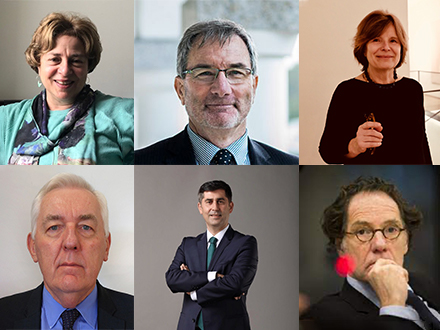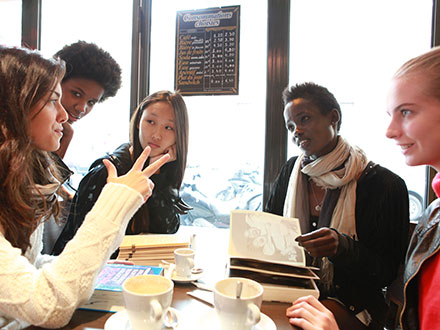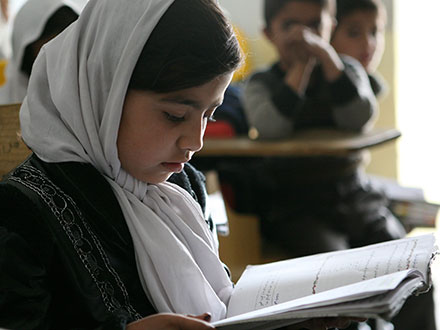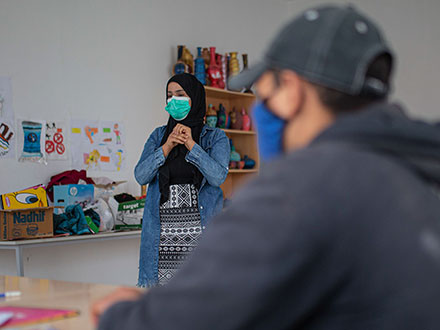Lessons from Christchurch: Recognizing the victims of terrorist acts
by Dr. Richard Burchill and Dr. James Mehigan
On 27 August 2020, the High Court of New Zealand in Christchurch sentenced Brenton Tarrant to life imprisonment with no parole for committing fifty-one acts of murder, forty acts of attempted murder, and one act of terrorism for an attack carried out on 15 March 2019 in Christchurch.
Tarrant’s attack shocked New Zealand and the world. It was by far the largest mass shooting for New Zealand in modern times. Tarrant arranged his attack as a social media event demonstrating the brutality of his actions and the reprehensible nature of extremist ideologies.
Following the attack, the New Zealand Government took a number of measures to ensure the victims and their families were supported. There were expressions of empathy and solidarity with the victims displayed by politicians, communities, and individuals. In the wake of a terrorist attack, outreach in terms of direct support and empathy for victims of terrorist acts is essential. It helps to reassure those feeling vulnerable, it shows society’s rejection of the extremist ideologies, and maintains levels of communication and connection with any particular group(s) targeted by the terrorist act. Such measures are essential over the long term as they support efforts in countering extremism through collective action.
Significantly, through the criminal justice process for prosecuting Tarrant, New Zealand demonstrated a strong approach towards recognising the victims as key participants going forward and not just as nameless victims of an attack; something that is often missing from the criminal justice response to terrorist attacks. Over a three-day period in August, victims of the attack (victims here is understood as those who survived the attack and family members of both those who were killed and those who survived) were able to confront Tarrant in a courtroom to express their emotions, feelings, pain, and anguish. Victims were given a platform for expressing their anger and pain, projecting the human impact that results from terrorist acts. Sara Qasem, the daughter of Abdelfattah Qasem who was killed on the day expressed to Tarrant
“I wonder if he was in pain, if he was frightened, and what his final thoughts were. And I wish more than anything in the world that I could have been there to hold his hand and tell him it would all be ok. But I couldn’t do that.”
The father of Sayyad Ahmad Milne, John Milne, told Tarrant that
“The last words I would hear from Sayed, for now, were ‘cuddle me’. Oh how I regret not doing that, the last time I saw him alive when he left for school that fateful morning.”
There was widespread coverage of the victims’ testimonies providing a public display for showing how the extremist beliefs of the terrorist are wrong and providing narratives that may influence others who may hold beliefs similar to the perpetrator.
The voice and experiences of the victims were given further prominence in the sentencing remarks of Justice Cameron Mander.[1] The sentencing remarks come to forty-four pages and in this document, Justice Mander provides a narrative about each individual victim. In over forty paragraphs the judge identified each of the victims, giving a summary about the individual along with references from the victims’ statements received from the families. For example, the remarks tell of Sazada Akhter who “was found lying on the road. She received a gunshot wound to her chest and her spine was fractured. This young woman is now confined to a wheelchair and will need special care for the rest of her life. She is only 26 years old.”
And the father of Sara Qasem, Abdelfattah Qasem, described as:
“a kind-hearted, selfless and hardworking husband and father who helped his neighbours and friends. For 32 years he and his wife used to hold hands. She no longer has him to hold hands with — instead she faces retirement alone. Mr. Qasem will never meet his grandson, who was born two months after he died. The family has lost their pillar and is forever traumatised by his death.”
These remarks reinforced the humanity of the victims demonstrating the waste and futility of terrorist attacks. The sentencing remarks by the judge are not just a summary of the attack, rather it is a commemoration of each life that was lost and injured on the day. Extensive reinforcement of the humanity of the victims in the legal process is significant as this is an official narrative reinforcing that Tarrant’s extremist views have no place in society.
“I wonder if he was in pain, if he was frightened, and what his final thoughts were. And I wish more than anything in the world that I could have been there to hold his hand and tell him it would all be ok. But I couldn't do that."
Sara Qasem daughter of Abdelfattah Qasem who was killed on the day expressed to TarrantThe New Zealand court’s actions in telling the personal stories of the victims in the sentencing statement and allowing over ninety individuals to voice their pain and suffering in a public setting showed that the victims are distinct human beings with their own stories and experiences. The terrorist act is a rejection of shared humanity in society as the perpetrator has no concern for the lives of others. Too often the response to terrorist acts is limited with the numbers of victims published, the background of the perpetrator discussed, and a few human-interest stories discussed. The New Zealand process demonstrates the importance and value of listening to victims and seeing how a terrorist act has impacted their lives and wider society. It stands as an example of the UN Secretary-General’s call for greater recognition of victims of terrorism as –
“To support victims and to listen to their voices is a meaningful way for us to prove that we care — and to negate the terrorist [narrative].”[2]
Globally, practice in criminal justice systems tends to exclude and marginalise victims in the conduct of proceedings. There are examples of good practice in some jurisdictions where victims are able to give statements to a court regarding the impact of the crime perpetrated. In terrorism trials, victims often face further marginalisation. In states where transparency in the legal system is lacking or the rule of law is not a priority, victims typically have no role as the purpose of the trial is exclusively about the state meeting out punishment.
In states where the rule of law and fair trial rights are foundational to the legal system, terrorism trials pose a number of challenges. Trials for terrorist acts should be conducted as a normal criminal trial to demonstrate that the terrorist has failed in their attempt to disrupt society. This may prove difficult for the victims as it will mean the accused is presumed innocent until proven guilty and fair trial rights are to be recognised. Victims may have to experience the violence again through being cross-examined as witnesses or when listening to the defence testimony. In many cases, the prosecution may see the victims as no more than witnesses. However, it is important to prosecute terrorist acts in public trials with fair trial rights recognised as this reinforces that the system as a whole does not share the extremist’s ideology and has not given in to the attack.
The UN Office for Drugs and Crime has produced a manual on Good Practices in Supporting Victims of Terrorism within the Criminal Justice Framework (2015) which emphasises the need to ensure victims feel included and supported throughout the criminal proceedings. In this regard, there should be opportunities for victims to provide accounts of their experiences in a way that publicly demonstrates the impact the terrorist act has had upon them and their families. Failing to ensure victims have agency and input into the trial process results in further victimisation and an unnecessary strain upon individuals that have already been through traumatic events. This secondary victimisation may be utilised by those seeking to fuel their own extremist narratives. In these situations, those claiming the same identity as the victims attempt to argue that the state does not care about their collective group, using the trial as a further example of grievances held by the group. The trial process and marginalisation of the victims are utilised in arguments that there is no respect for their identity group and that the exclusion of victims in the trial is part of a wider rejection of that group by society.
The experiences of victims following terrorist acts should not be allowed to contribute to reinforcing extremist narratives. Instead, the victims’ experience, if appropriately supported, provides an important dimension in countering violent extremism.[3] The victims’ experience provides a record of events, a history of what has occurred that goes beyond an account of the basic facts. When victims have the opportunity to voice their feelings, it provides the human dimension of the impact the violent attack has had in a way that has resonance across society. The voice and recognition of the victims provide a direct source to counter extremists by showing the human story of the damages brought by the violent acts. In the New Zealand case, the ability of victims to express their views directly to the accused and for the public to see is strong in showing the unnecessary futility of terrorism. It can be hoped that observers who may have had some sympathy with the terrorist are convinced to change their views.
“To support victims and to listen to their voices is a meaningful way for us to prove that we care — and to negate the terrorist [narrative].”[2]
UN Secretary-GeneralThe sentencing process conducted by New Zealand demonstrated the human side, the pain, and suffering caused by a terrorist attack. It allowed individuals and families the opportunity to publicly express their grief. This has an important long-term impact as the communities and individuals that identify with the in-group of the victims are able to see respect for victims in the trial process. Too often when the fair trial rights of the accused are recognised, victims and their supporters can claim marginalisation or further victimisation due to the lack of respect or recognition for the victim in relation to the accused. This allows for claims of group victimisation due to the actions of the state that then feed into narratives in support of extremist ideologies. Even when the perpetrator is found guilty and punished if the victims are marginalised then accusations of exclusion can be formulated. In times of trauma, this is understandable, and more can be done overall in support of victims in every situation. At the same time, the recognition given in the criminal justice process in New Zealand has been significant and will serve to detract those seeking to use the trial and sentencing as evidence in support of extremist views.
It is important to note that there is no one model for ensuring victims are recognised and respected in the criminal process. While it is important to give victims of terrorist acts recognition and voice, a criminal justice system based on the rule of law cannot take emotion and outrage as the primary determinants of how the trial is conducted or the sentence that follows a guilty judgment. Victims will tend to express the view that a drawn-out trial, or a trial at all, is unnecessary when, as in the case of Tarrant, the evidence was clear. In criminal justice more broadly victims will call for more and require actions more in line with their direct interests rather than considerations for the wider system and the public importance of the trial and proportionate sentencing.
The needs of victims and their social groups will change over time as the impact of a terrorist act does not just go away after the event and subsequent trial. The terrorist trial, however, is a fixed event in the public record. In the New Zealand case, the voices and experiences of the victims are now a permanent part of the public record, as well as a significant part of the case record. This will stand as a significant contribution to CVE as the prominent victim presence makes clear how extremist behaviour damages society. As stated by the UN Secretary-General when establishing a victim’s network at the global level “Your stories of how terrorism has affected your lives are our strongest argument why it can never be justified. By giving a human face to the painful consequences of terrorism, you help build a global culture against it.”[4]
Much more needs to be done globally in supporting victims of terrorist acts. The legal case is just one dimension of the victims’ stories, other outlets, and possibilities throughout their lifetimes are important. There is growing recognition of the importance of recognising the victims of terrorism and support for a range of actions at different levels of society needs to be strengthened. Acknowledging victims of terrorism in criminal proceedings is an important part of recognising the humanity of the victims, an essential dimension to rebuilding and healing, individually and collectively, after an attack.[5]
In the Christchurch case, the victims were given the opportunity to show to the terrorist and the public that they have not been defeated by his acts. The victims demonstrated strength in being able to directly face Tarrant and express their feelings and emotions. Of course, this is an individual choice for the victims. It is important to understand that victims are not required to submit impact statements or cannot be forced to appear. At the same time, the extent to which the New Zealand criminal justice system gave a platform to the victims, as well as recognition in the case record, supports healing strategies as well as demonstrating that the terrorist failed in his deplorable aspirations.
References
[1] R v Tarrant (sentencing) [2020] NZHC 2192, available at https://courtsofnz.govt.nz/cases/r-v-tarrant-1.
[2] UN Press Release, “Amplifying Voices of Victims Critical to Countering Terrorist Narratives, Stresses Secretary-General, as International Remembrance Day Exhibition Opens” UN Doc. SG/SM/19170-OBV/1812 17 August 2018, available at https://www.un.org/press/en/2018/sgsm19170.doc.htm.
[3] RAN Working Group on Victims of Terrorism, Handbook: Voices of victims of terrorism 2015, available at https://bit.ly/3bCK3Mi.
[4] UN Press Release, “Secretary-General, at Symposium, says scourge of terrorism attacks humanity itself; voices of victims ‘strongest argument why it can never be justified’.” UN Doc SG/SM/11778, 9 September 2008, available at https://www.un.org/press/en/2008/sgsm11778.doc.htm.
[5] Report of the Secretary General Progress made by the United Nations system in supporting Member States in assisting victims of terrorism, UN Doc A/74/790, 8 April 2020, available at https://www.un.org/victimsofterrorism/en/node/5823.
About Hedayah's Blog Series
Hedayah publishes a monthly blog series covering a range of different topics related to counter violent extremism (CVE). These blogs highlight the latest trends and challenges faced by the CVE world and highlight topics that receive less attention in the international CVE space with a unique perspective.
The authors of the blog posts are Hedayah’s staff, Hedayah’s Fellows, and guest experts. The opinions expressed in the blogs are their own and not representative of Hedayah. We hope that these blogs will contribute to the conversation around CVE solutions, and push forward the quest for more research and innovation in the field.










